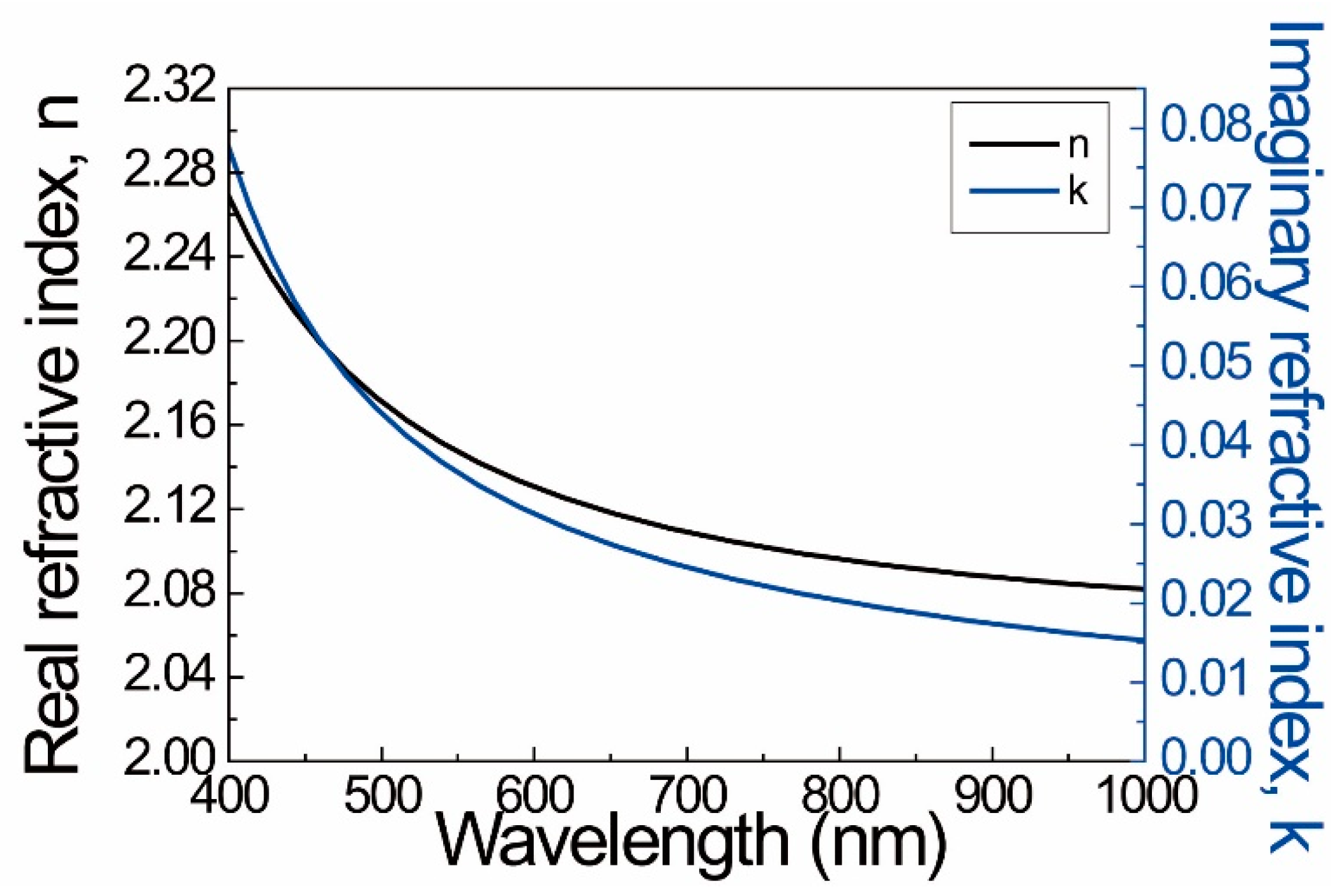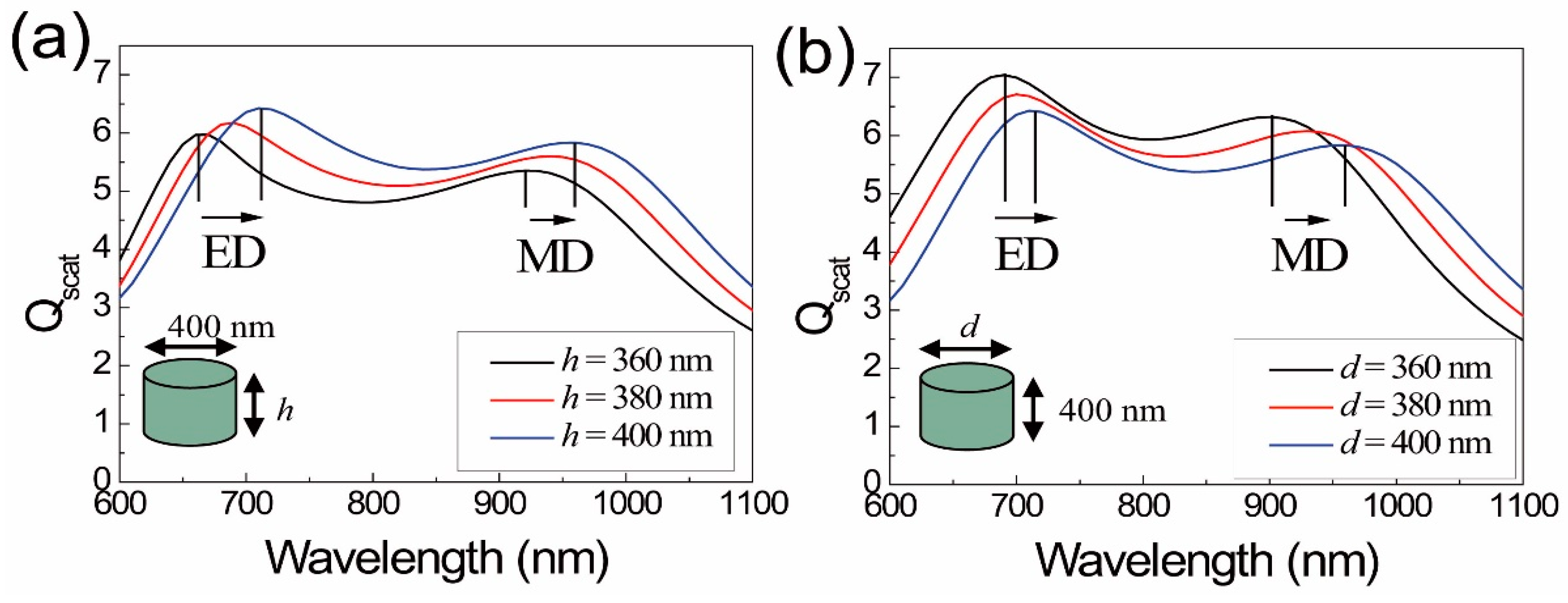Wavelength Conversion Enhancement Achieved by Using Resonance in an Array of Nanocylinders
Abstract
:1. Introduction
2. Upconversion Material Nanocylinder
2.1. Electric and Magnetic Dipole Resonances in a UC Nanocylinder
2.2. Tailoring the Wavelengths of ED and MD Resonances
2.3. Periodic Structure of UC Nanocylinders
2.4. UC Nanocylinder on a Gold Substrate and an Absorption Enhancement at 980 nm
2.5. Spontaneous Emission Enhancement at 660 nm
3. Conclusions
Acknowledgments
Author Contributions
Conflicts of Interest
Appendix A

References
- Menyuk, N.; Dwight, K.; Pierce, J.W. NaYF4: Yb,Er—An efficient upconversion phosphor. Appl. Phys. Lett. 1972, 21, 159. [Google Scholar] [CrossRef]
- Yi, G.S.; Chow, G.M. Synthesis of hexagonal-phase NaYF4:Yb,Er and NaYF4:Yb,Tm nanocrystals with efficient up-conversion fluorescence. Adv. Funct. Mater. 2006, 16, 2324–2329. [Google Scholar] [CrossRef]
- Van Sark, W.G.J.H.M.; de Wold, J.; Rath, J.K.; Meijerink, A.; Schropp, R.E.I. Upconversion in solar cells. Nanoscale Res. Lett. 2013, 8, 81. [Google Scholar] [CrossRef] [PubMed]
- Cheng, Y.Y.; Fuckel, B.; MacQueen, R.W.; Khoury, T.; Clady, R.G.C.R.; Schylze, T.F.; Ekins-Daukes, N.J.; Crossley, M.J.; Stannowski, B.; Lips, K.; et al. Improving the light-harvesting of amorphous silicon solar cells with photochemical upconversion. Energy Environ. Sci. 2012, 5, 6953–6959. [Google Scholar] [CrossRef]
- Ramachari, D.; Esparza, D.; Lopez-Luke, T.; Romero, V.H.; Perez-Mayen, L.; De la Rosa, E.; Jayasankar, C.K. Synthesis of co-doped Yb3+-Er3+:ZrO2 upconversion nanoparticles and their applications in enhanced photovoltaic properties of quantum dot sensitized solar cells. J. Alloys Compd. 2017, 698, 433–441. [Google Scholar] [CrossRef]
- Yu, J.; Yang, Y.L.; Fan, R.Q.; Wang, P.; Dong, Y.W. Enhanced photovoltaic performance of dye-sensitized solar cells using a new photoelectrode material: Upconversion YbF3-Ho/TiO2 nanoheterostructures. Nanoscale 2016, 8, 4173–4180. [Google Scholar] [CrossRef] [PubMed]
- Nyk, M.; Kumar, R.; Ohulchanskyy, T.Y.; Bergey, E.J.; Prasad, P.N. High Contrast in Vitro and in Vivo Photoluminescence Bioimaging Using Near Infrared to Near Infrared Up-Conversion in TM3+ and Yb3+ Doped Fluoride. Nano Lett. 2008, 8, 3834–3838. [Google Scholar] [CrossRef] [PubMed]
- Xiong, L.Q.; Chen, Z.G.; Yu, M.X.; Li, F.Y.; Liu, C.; Huang, C.H. Synthesis, characterization, and in vivo targeted imaging of amine-functionalized rare-earth up-converting nanophosphors. Biomaterials 2009, 30, 5592–5600. [Google Scholar] [CrossRef] [PubMed]
- Lin, H.; Jiang, S.B.; Wu, J.F.; Song, F.; Peyghambarian, N.; Pun, E.Y.B. Er3+ doped Na2O-Nb2O5-TeO2 glasses for optical waveguide laser and amplifier. J. Phys. D Appl. Phys. 2003, 36, 812–817. [Google Scholar] [CrossRef]
- Singh, S.K.; Kumar, K.; Rai, S.B. Diode laser pumped Gd2O3:Er3+/Yb3+ phosphor as optical nano-heater. Appl. Phys. B 2010, 100, 443–446. [Google Scholar] [CrossRef]
- Shalav, A.; Richards, B.S.; Trupke, T.; Kramer, K.W.; Gudel, H.U. Application of NaYF4: Er3+ up-converting phosphors for enhanced near-infrared silicon solar cell response. Appl. Phys. Lett. 2005, 86, 013505. [Google Scholar] [CrossRef]
- Lee, G.Y.; Jung, K.; Jang, H.S.; Kyhm, J.; Han, I.K.; Park, B.; Ju, H.; Kwon, S.J.; Ko, H. Upconversion luminescence enhancement in plasmonic architecture with random assembly of metal nanodomes. Nanocsale 2016, 8, 2071–2080. [Google Scholar] [CrossRef] [PubMed]
- Park, K.; Jung, K.; Kwon, S.J.; Jang, H.S.; Byun, D.; Han, I.K.; Ko, H. Plasmonic nanowire-enhanced upconversion luminescence for anticounterfeit Devices. Adv. Funct. Mater. 2016, 26, 7836–7846. [Google Scholar] [CrossRef]
- Guo, K.M.; Li, M.Y.; Fang, X.L.; Liu, X.L.; Zhu, Y.D.; Hu, Z.Q.; Zhao, X.Z. Enhancement of properties of dye-sensitized solar cells by surface plasmon resonance of Ag nanowire core-shell structure in TiO2 films. J. Mater. Chem. A 2013, 1, 7229–7234. [Google Scholar] [CrossRef]
- Nam, M.; Kwon, N.-K.; Kwon, S.J.; Kwon, S.-H.; Cha, M.; Lee, S.-H.; Park, S.; Jeong, D.; Lee, K.-T.; Rhee, H.; et al. Multi-Functional Transparent Luminescent Configurationfor Advanced Photovoltaics. Adv. Energy Mater. 2016, 6, 1502404. [Google Scholar] [CrossRef]
- Bezares, F.J.; Long, J.P.; Glembocki, O.J.; Guo, J.P.; Rendell, R.W.; Kasica, R.; Shirey, L.; Owrutsky, J.C.; Caldwell, J.D. Mie resonance-enhanced light absorption in periodic silicon nanopillar arrays. Opt. Express 2013, 21, 27587–27601. [Google Scholar] [CrossRef] [PubMed]
- Liu, X.M.; Zhao, Q.; Lan, C.W.; Zhou, J. Isotropic Mie resonance-based metamaterial perfect absorber. Appl. Phys. Lett. 2013, 103, 031910. [Google Scholar] [CrossRef]
- Callewaert, F.; Chen, S.; Butun, S.; Aydin, K. Narrow band absorber based on a dielectric nanodisk array on silver film. J. Opt. 2016, 18, 075006. [Google Scholar] [CrossRef]
- Hong, S.; Lee, Y.J.; Moon, K.; Kwon, S.H. Double resonance perfect absorption in a dielectric nanoparticle array. Curr. Opt. Photonics 2017, 1, 228–232. [Google Scholar] [CrossRef]
- Cheng, J.R.; Ansari-Oghol-Beig, D.; Mosallaei, H. Wave manipulation with designer dielectric metasurfaces. Opt. Lett. 2014, 39, 6285–6288. [Google Scholar] [CrossRef] [PubMed]
- Gaillot, D.P.; Croenne, C.; Zhang, F.; Lippens, D. Transformation optics for the full dielectric electromagnetic cloak and metal-dielectric planar hyperlens. New J. Phys. 2008, 10, 115039. [Google Scholar] [CrossRef]
- Moitra, P.; Slovick, B.A.; Li, W.; Kraychencko, I.I.; Briggs, D.P.; Krishnamurthy, S.; Valentine, J. Large-scale all-dielectric metamaterial perfect reflectors. ACS Photonics 2015, 2, 692–698. [Google Scholar] [CrossRef]
- Moitra, P.; Slovick, B.A.; Yu, Z.G.; Krishnamurthy, S.; Valentine, J. Experimental demonstration of a broadband all-dielectric metamaterial perfect reflector. Appl. Phys. Lett. 2014, 104, 171102. [Google Scholar] [CrossRef]
- Slovick, B.; Yu, Z.G.; Berding, M.; Krishnamurthy, S. Perfect dielectric-metamaterial reflector. Phys. Rev. B 2013, 88, 165116. [Google Scholar] [CrossRef]
- Sun, S.Y.; Ge, Y.Y.; Zhao, Y.J.; Yuan, X.Y.; Zhao, Y.Z.; Zhou, H.P. Up-conversion luminescence behaviors in Er3+ doped single crystal KNbO3 nanosheets. RSC Adv. 2016, 6, 113038–113044. [Google Scholar] [CrossRef]
- Balakrishnaiah, R.; Kim, D.W.; Yi, S.S.; Kim, K.D.; Kim, S.H.; Jang, K.W.; Lee, H.S.; Jeong, J.H. Frequency upconversion fluorescence studies of Er3+/Yb3+-codoped KNbO3 phosphors. Thin Solid Films 2009, 517, 4138–4142. [Google Scholar] [CrossRef]
- Wang, Y.L.; Wang, L.H.; Zhao, Y.J.; Yan, D. Improved luminescence behavior in Er3+ doped KNbO3 perovskite structure ceramics. Ceram. Int. 2016, 42, 17911–17915. [Google Scholar] [CrossRef]
- Johnson, P.B.; Christy, R.W. Optical constants of the noble metals. Phys. Rev. B 1972, 6, 4370. [Google Scholar] [CrossRef]
- Ee, H.S.; Kim, S.K.; Kwon, S.H.; Park, H.G. Design of polarization-selective light emitters using one-dimensional metal grating mirror. Opt. Express 2011, 19, 1609–1616. [Google Scholar] [CrossRef] [PubMed]
- Purcell, E.M.; Torrey, H.C.; Pound, R.V. Resonance absorption by nuclear magnetic moments in a solid. Phys. Rev. 1946, 69, 37. [Google Scholar] [CrossRef]
- Simoes, A.Z.; Ries, A.; Riccardi, C.S.; Gonzalez, A.H.; Zaghete, M.A.; Stojanovic, B.D.; Cilense, M.; Varela, J.A. Potassium niobate thin films prepared through polymeric precursor method. Mater. Lett. 2004, 58, 2537–2540. [Google Scholar] [CrossRef]
- Nozaki, K.; Baba, T. Carrier and photon analyses of photonic microlasers by two-dimensional rate equations. IEEE J. Sel. Areas Commun. 2005, 23, 1411–1417. [Google Scholar] [CrossRef]
- Li, H.; Zhang, C.-Y.; Li, X.-F.; Xiang, J.; Tie, S.-L.; Lan, S. Enhanced upconversion luminescence from ZnO/Zn hybrid nanostructures induced on a Zn foil by femtosecond laser ablation. Opt. Express 2015, 23, 30118–30126. [Google Scholar] [CrossRef] [PubMed]
- Oda, H.; Yamanaka, A.; Ozaki, N.; Ikeda, N.; Sugimoto, Y. Operation of an InAs quantum-dot embedded GaAs photonic crystal slab waveguide laser by using two-photon pumping for photonics integrated circuits. AIP Adv. 2016, 6, 065215. [Google Scholar] [CrossRef]





| Cylinder (h 300_d 500) | Reference | |||||
|---|---|---|---|---|---|---|
| SE Enhancement | ηz | SE Enhancement | ηz | |||
| E‖ | 0.62 | 0.66 | 1.0 | 0.11 | 3.8 | 7.3 |
| Ez | 1.1 | 0.53 | 1.5 | 0.01 | 41 | |
© 2017 by the authors. Licensee MDPI, Basel, Switzerland. This article is an open access article distributed under the terms and conditions of the Creative Commons Attribution (CC BY) license (http://creativecommons.org/licenses/by/4.0/).
Share and Cite
Moon, K.; Lee, Y.J.; Hong, S.; Kwon, S.-H. Wavelength Conversion Enhancement Achieved by Using Resonance in an Array of Nanocylinders. Appl. Sci. 2017, 7, 1246. https://doi.org/10.3390/app7121246
Moon K, Lee YJ, Hong S, Kwon S-H. Wavelength Conversion Enhancement Achieved by Using Resonance in an Array of Nanocylinders. Applied Sciences. 2017; 7(12):1246. https://doi.org/10.3390/app7121246
Chicago/Turabian StyleMoon, Kihwan, Young Jin Lee, Seokhyeon Hong, and Soon-Hong Kwon. 2017. "Wavelength Conversion Enhancement Achieved by Using Resonance in an Array of Nanocylinders" Applied Sciences 7, no. 12: 1246. https://doi.org/10.3390/app7121246





